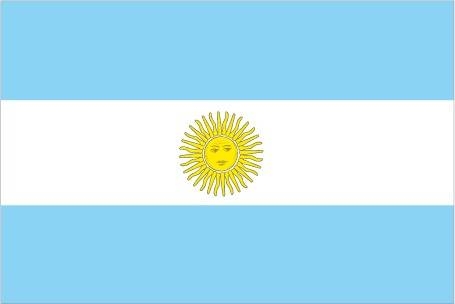Country Summary




Introduction
Background
In 1816, the United Provinces of the Rio Plata declared their independence from Spain. After Bolivia, Paraguay, and Uruguay left, the area that remained became Argentina. The country's population and culture were heavily shaped by immigrants from throughout Europe.
Geography
Area
total: 2,780,400 sq km
land: 2,736,690 sq km
water: 43,710 sq km
Climate
mostly temperate; arid in southeast; subantarctic in southwest
Natural resources
fertile plains of the pampas, lead, zinc, tin, copper, iron ore, manganese, petroleum, uranium, arable land
People and Society
Population
46,245,668 (2022 est.)
Ethnic groups
European (mostly Spanish and Italian descent) and Mestizo (mixed European and Amerindian ancestry) 97.2%, Amerindian 2.4%, African descent 0.4% (2010 est.)
Languages
Spanish (official), Italian, English, German, French, indigenous (Quechua, Guarani, Mapudungun)
Religions
Roman Catholic 62.9%, Evangelical 15.3% (Pentecostal 13%, other Evangelical 2.3%), Jehovah's Witness and Church of Jesus Christ 1.4%, other 1.2% (includes Muslim, Jewish), none 18.9% (includes agnostic and atheist), unspecified 0.3% (2019 est.)
Population growth rate
0.82% (2022 est.)
Government
Government type
presidential republic
Capital
name: Buenos Aires
Executive branch
chief of state: President Alberto Angel FERNANDEZ (since 10 December 2019); Vice President Cristina FERNANDEZ DE KIRCHNER (since 10 December 2019); note - the president is both chief of state and head of government
head of government: President Alberto Angel FERNANDEZ (since 10 December 2019); Vice President Cristina FERNANDEZ DE KIRCHNER (since 10 December 2019)
Legislative branch
description: bicameral National Congress or Congreso Nacional consists of:
Senate or Senado (72 seats; members directly elected on a provincial basis with 2 seats awarded to the party with the most votes and 1 seat to the party with the second highest number of votes; members serve 6-year terms with one-third of the membership renewed every 2 years)
Chamber of Deputies or Cámara de Diputados (257 seats; members directly elected in multi-seat constituencies by party-list proportional representation vote using the D'Hondt method; members serve 4-year terms with one-half of the membership renewed every 2 years)
Economy
Economic overview
large diversified economy; financial risks from debt obligations, rapid inflation, and reduced investor appetites; resource-rich, export-led growth model; increasing trade relations with China; G20 and OAS leader; tendency to nationalize businesses and under-report inflation
Real GDP (purchasing power parity)
$893.31 billion (2020 est.)
Real GDP per capita
$19,700 (2020 est.)
Agricultural products
maize, soybeans, wheat, sugar cane, milk, barley, sunflower seed, beef, grapes, potatoes
Industries
food processing, motor vehicles, consumer durables, textiles, chemicals and petrochemicals, printing, metallurgy, steel
Exports
$64.18 billion (2020 est.)
Exports - partners
Brazil 16%, China 11%, United States 7%, Chile 5% (2019)
Exports - commodities
soybean products, corn, delivery trucks, wheat, frozen meat, gold (2019)
Imports
$52.14 billion (2020 est.)
Imports - partners
Brazil 21%, China 18%, US 14%, Germany 6% (2019)
Imports - commodities
cars, refined petroleum, vehicle parts, natural gas, soybeans (2019)
Exchange rates
Argentine pesos (ARS) per US dollar -
Page last updated: Thursday, December 15, 2022
